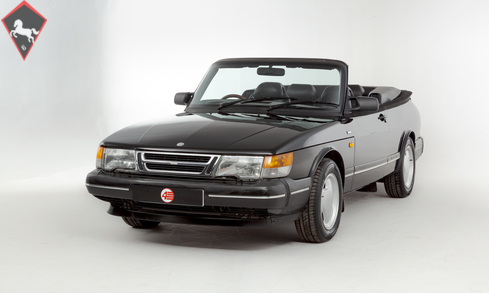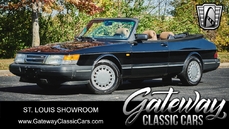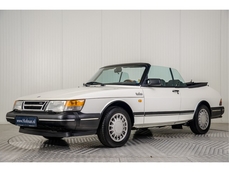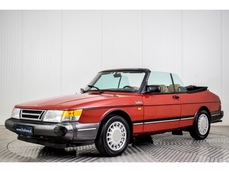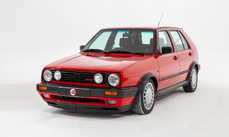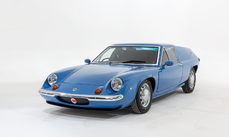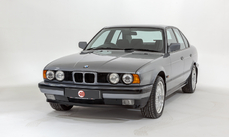Saab 900 16v Cabriolet 1992
Allgemeine Beschreibung :
Model History
The Saab 900 was produced from 1978 until 1998. The first generation (produced until 1993) is known as the "classic" while the 1994-1998 models are known as the "new generation”. The classic 900 was based on the 99 chassis while the later models used that of the Opel Vectra. General Motors’ influence from 1994 marked the end of Saab's technology-driven design philosophy and the beginning of the dilution of the Saab brand.
The 900 sported a deeply curved front windscreen, providing the best driver visibility, calling attention to the marque's aircraft legacy. Also underscoring their aircraft lineage, the 900's dashboard was curved to enable easy reach of all controls and featured gauges lit up from the front. Saab engineers placed all controls and gauges in the dashboard according to their frequency of use and/or importance, so that the driver need only divert their gaze from the road for the shortest possible time and by the smallest angle. This is why, for example, the oft-used radio is placed so high in the dashboard.
In keeping with the paradigm of its predecessor, the 99 model, the 900 employed a door design unique in automotive manufacturing, with an undercutting sweep to meet the undercarriage, forming a tight, solid unit when the door was closed. This feature also eliminated the stoop in the cabin at the footing of the door, as seen in automobiles of other manufacturers, thereby preventing water and debris from collecting and possibly entering the cabin or initiating corrosion, as well as enabling passengers to enter and exit the cabin without need to step over several inches of ledge.
The 900 underwent minor cosmetic design changes for 1987, including restyled front-end and bumpers that went from a vertical to a more sloped design; sheet metal body parts were unchanged. Being a small car factory, for economic reasons, Saab kept the basic undercarriage more or less unchanged throughout the 900's production run.
Production of the first 900 cabriolet started during the spring of 1986. The convertibles predominantly featured a turbocharged 16v engine but were also offered with a fuel-injected naturally aspirated engine, as featured here.
Equipment
Electric-folding roof, Tonneau cover with storage bag, Electric windows, Kenwood CD player with Bluetooth, Electrically adjustable door mirrors, Spare wheel and jack, Nardi wooden steering wheel, Lockable glovebox, Cigarette lighter, Spare key.
Exterior
The black paintwork is very well preserved throughout with only a few discreet areas showing age-related marks. Towards the front of the car the body is in good order with no major blemishes to report. The oversized bumpers and black trim are in fine fettle with no fading and just a few scuffs to be found on close inspection. The black electrically-operated soft-top works exactly as it should and remains in excellent condition having been replaced in 2015 at a cost of over £900. This example also comes with the rare tonneau cover and storage bag, both of which are in perfect condition.
Interior
The classic Saab interior is a very pleasing place to sit. The first thing you’ll notice is the beautiful 3-spoke wood rim Nardi steering wheel, a great looking option that feels lovely in-hand – the original steering wheel is still present. A tasteful Kenwood CD player with Bluetooth is in place for modern convenience. The seats are trimmed in black leather, a great colour combo with the black roof and bodywork. All the seats are in fine order with no major wear to be found on any of the bolsters or bases. Lifting the rear hatch you’ll find a clean load compartment with the alloy spare wheel and jack, which is located neatly beneath the removable floor panels.
ENGINE & TRANSMISSION
The Saab is equipped with a two-litre naturally aspirated 16v engine producing 123hp. On first turn of the key the car fires quickly into life and idles up to temperature smoothly. Despite its modest performance figures the 900i provides a smooth yet engaging drive with plenty of Swedish charm.
With just 119k miles to its name – reasonably low mileage in Saab terms – the engine pulls well and the auto ‘box shifts seamlessly through the gears. The car has recently been inspected on arrival at 4 Star, with a clean bill of health and MOT valid until May 2020.
WHEELS, TYRES & BRAKES
The retro 15-inch Saab Directional alloy wheels look fantastic and remain in good order all round with the exception of a few light curb marks. The wheels are shod in matching Pirelli Cinturato rubber; the front tyres are brand new and the rears have plenty of tread remaining. The brake pads and discs were replaced all round upon arrival with us.
History File
This charming 900i was first registered January 1992; it was sold through the supplying dealer Saab City, London. Within the History File the original Saab document pack is still present with all the manuals and booklets. The service booklet contains 19 stamps. Various invoices for replacement parts and health checks can be found along with old MOT certificates.
http://www.4starclassics.com/for-sale/saab-900i-16v-cabriolet-for-sale/
1992 Saab 900 16v Cabriolet is listed verkauft on ClassicDigest in Kingsley by 4 Star Classics for £7495.
Fakten der Auto
Karosserietyp : Auto Marke : Saab Modell : 900 Ausführung : 16v Cabriolet Hubraum : 2.0 Modelljahr : 1992 Karosstyp : Convertible Lage : Hampshire
Verkauft
Angaben Zum Verkäufer
Verkauft
People who viewed this Saab 900 also viewed similar Saab listed at ClassicDigest
Other cars listed for sale by this dealer
über Saab
Saab, ursprünglich ein Akronym für Svenska Aeroplan Aktiebolaget (Schwedische Flugzeuggesellschaft), begann seine Reise als Flugzeughersteller im Jahr 1937. Saab wurde in Schweden gegründet und konzentrierte sich hauptsächlich auf die Produktion von Kampfflugzeugen und Militärflugzeugen. Im Laufe der Zeit diversifizierte das Unternehmen seine Interessen und wagte sich in die Automobilherstellung, was schließlich zur Entwicklung eigenartiger, aber innovativer Autos führte, die in der Automobilindustrie herausragten.Herstellung von Kampfflugzeugen:
Die Geschichte von Saab in der Luftfahrtindustrie war geprägt von der Produktion innovativer Kampfflugzeuge. Eines seiner bekanntesten Flugzeuge war die Saab 29 Tunnan, die Anfang der 1950er Jahre eingeführt wurde. Der Tunnan zeichnete sich durch sein einzigartiges Design mit einem tonnenförmigen Rumpf aus, was ihm den Spitznamen „The Flying Barrel“ einbrachte. Es wurde von einem einzigen Strahltriebwerk angetrieben und war Schwedens erstes im Inland produziertes Kampfflugzeug mit Strahlantrieb.
Nach dem Erfolg des Tunnan entwickelte Saab weiterhin fortschrittliche Militärflugzeuge. Der Ende der 1950er Jahre eingeführte Saab 35 Draken war ein weiterer Meilenstein für das Unternehmen. Die Draken war ein Delta-Flügel-Abfangjäger, der für seine bemerkenswerte Geschwindigkeit und die charakteristische Doppel-Delta-Flügelkonfiguration bekannt war. Sein innovatives Design ermöglichte eine hervorragende Manövrierfähigkeit und Leistung und machte es über mehrere Jahrzehnte zu einem bedeutenden Aktivposten im schwedischen Luftverteidigungsarsenal.
Übergang zum Automobilbau:
In den späten 1940er Jahren weitete Saab seine Aktivitäten auf die Automobilindustrie aus. Der erste Ausflug des Unternehmens in den Automobilbau führte zur Produktion des Saab 92, der 1949 auf den Markt kam. Der Saab 92 war ein kompaktes und aerodynamisches Auto, das von einem Zweizylinder-Zweitaktmotor angetrieben wurde. Sein unkonventionelles Design mit stromlinienförmiger Form und Frontantrieb unterschied ihn von anderen Autos seiner Zeit.
Während Saab seine Innovationen fortsetzte, führte das Unternehmen mehrere bemerkenswerte Modelle auf dem Automobilmarkt ein. Der Ende der 1960er Jahre auf den Markt gebrachte Saab 99 war ein bedeutender Meilenstein für das Unternehmen. Es zeichnete sich durch ein unverwechselbares Design aus, darunter eine umlaufende Windschutzscheibe und ein einzigartiges „Hockeyschläger“-Profil, das ihm ein wiedererkennbares Aussehen verlieh. Der Saab 99 führte auch technische Fortschritte wie Turboaufladung ein, die Leistung und Kraftstoffeffizienz steigerten.
Die Entwicklung wurde mit dem Ende der 1970er Jahre eingeführten Saab 900 fortgesetzt, der zu einem der kultigsten Modelle des Unternehmens wurde. Der Saab 900 war bekannt für seine robuste Bauqualität, innovative Sicherheitsfunktionen und unkonventionelle Designelemente, einschließlich der charakteristischen umlaufenden Windschutzscheibe. Er bot Turbomotoren und einen vielseitigen Fließheck-Karosseriestil und bediente damit einen Nischenmarkt, der Individualität und Zweckmäßigkeit suchte.
Technische Aspekte und Besonderheiten:
Saab-Autos zeichneten sich durch technische Innovationen und einzigartige Merkmale aus. Zu den herausragenden technischen Aspekten und Eigenheiten von Saab-Automobilen gehören:
Turboaufladung: Saab war einer der Pioniere bei der Verbreitung von Turbomotoren in Personenkraftwagen und steigerte die Leistung erheblich, ohne die Kraftstoffeffizienz zu beeinträchtigen.
Sicherheitsinnovationen: Saab legte großen Wert auf Sicherheit und führte verschiedene Sicherheitsfunktionen ein, darunter verstärkte Fahrgasträume, stoßabsorbierende Strukturen und fortschrittliche Bremssysteme.
Von Flugzeugen inspiriertes Design: Das Unternehmen integrierte Designelemente, die von seinem Luftfahrterbe inspiriert waren, wie aerodynamische Formen, umlaufende Windschutzscheiben und unkonventionelle Stilelemente.
Ergonomie und Praktikabilität: Saab-Autos waren bekannt für ihre komfortable Innenausstattung, innovative Ergonomie und praktische Funktionen wie die Platzierung des Zündschlüssels zwischen den Vordersitzen.
Skurrilität: Saab-Autos zeichneten sich oft durch unkonventionelle Designentscheidungen und -lösungen aus und sprachen ein Nischenpublikum an, das etwas anderes als die Mainstream-Automobilangebote suchte.
Der Weg von Saab vom renommierten Kampfflugzeughersteller zum Hersteller skurriler, aber innovativer Autos unterstreicht sein Engagement für Innovation, einzigartiges Design und technologischen Fortschritt sowohl in der Luftfahrt- als auch in der Automobilindustrie. Trotz Herausforderungen und Besitzerwechseln im Laufe der Jahre bleibt das Vermächtnis von Saab durch seinen ausgeprägten und unkonventionellen Ansatz bei Fahrzeugdesign und -technik bestehen.
